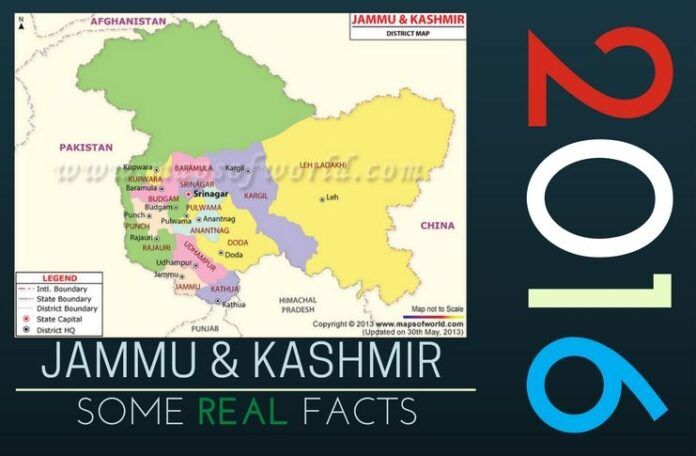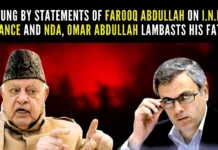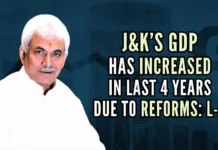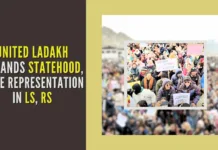
[dropcap color=”#008040″ boxed=”yes” boxed_radius=”8px” class=”” id=””]T[/dropcap]housands of essays on the genesis of and solution to the so-called Kashmir issue have appeared in national dailies and journals of repute during the last more than 27 years. More than 1000 books on the same theme and during the same period have also come out. Most of these works — barring the works on the forced exodus of over three lakh Kashmiri Hindus from the land of Vitasta (Jhelum) — were an attempt to express deep anguish over the orgy of death and destruction the Kashmir Valley, which constitutes a paltry five per cent of the State’s land area, has been witnessing since 1989 and suggest measures which could help restore peace and normality there. Nothing wrong. It was only natural.
The term “Kashmiriyat” was coined only in 1976 by a Jammu-based commentator and supporter of Sheikh Mohammad Abdullah…
A close scrutiny of whatever appeared during all these years of communal violence and turmoil in Jammu & Kashmir, however, reveals that all or nearly all those who penned down their views, for most part, refused to look beyond the highly prosperous and over-developed Kashmir Valley on the misguided notion that the Valley constitutes the entire State of Jammu & Kashmir and winning over the hearts of the “alienated” Kashmiri Muslims would be the same as meeting the needs and aspirations of the people of Jammu province and Ladakh region and all those who have never been considered part and parcel of “Kashmiriyat”. The term “Kashmiriyat” was coined only in 1976 by a Jammu-based commentator and supporter of Sheikh Mohammad Abdullah, a votary of plebiscite/ autonomy. A study of these writings also tells us that almost all the authors of these writings believe that the Valley’s gross political neglect, its under-development, the Centre’s indifferent attitude to the Valley’s economic needs and inadequate employment opportunities for educated Muslim young-men of the Valley are the four major breeders of terrorism in what was not so long ago “a paradise on earth”.
The assumption that the politico-economic neglect of the Valley has been responsible for the “alienation” of Kashmiri Muslims from the national mainstream, suffers from grave errors of analysis and judgment. The facts about the post-1947 Valley clear all the cobwebs of confusion and establish that right from the day of State’s accession to the Indian Dominion on October 26, 1947, political power, funds for developmental schemes and better deal in matters relating to employment and location of prestigious institutions and industrial units have become the sole privileges of the Valley with Jammu and Ladakh only getting crumbs. The rate of unemployment in the Valley is less than 30 per cent compared to over 69 per cent in Jammu province and all the Chief Ministers of the State till date have been from Kashmir belonging to the Sunni sect.
[dropcap color=”#008040″ boxed=”yes” boxed_radius=”8px” class=”” id=””]I[/dropcap]t is, however, a different matter that these analysts, like all the Valley leaders, describe the existing politico-constitutional set-up as “anti-Kashmiriyat” and put forth a formula that not only seeks to drive Jammu & Kashmir away from New Delhi, but also rejects outright the loud clamour of the people beyond the Valley for empowerment on the ground that the Valley makes no distinction between the Kashmiris and non-Kashmiris. They argue that the demand of non-Kashmiris, if accepted, would “hurt the Kashmiri psyche”. They, in addition, interpret the demand of the people of Jammu and Ladakh and others, who do not subscribe to the Valley’s communal and separatist ideology, for a meaningful decentralisation of the State power as the demand of the “rightists calculated to disintegrate the State”.
Two other very crucial factors were also overlooked by the framers of the State Constitution. One was the historical antagonism between the Valley and Jammu…
The arguments which these ‘trouble-shooters’ and protagonists of loose relations between Jammu & Kashmir and the Centre advance against the loud cry in different parts of the State, particularly Jammu and Ladakh regions, for reorganisation of the existing politico—constitutional, administrative and economic structure on a regional basis are as abstract as they are politically and communally-motivated. Any impartial observer and investigator with a secular and democratic outlook would at once vouch for the fact that there are cogent reasons for the people beyond the Valley to demand an instrument which caters to their basic needs. The severe inter-regional animosity and bitterness prevailing in Jammu & Kashmir demonstrates that the essentially unitary constitutional structure under which the State has been governing , particularly after January 26, 1957 has not produced the desired results. The prime reason is that the Jammu & Kashmir Constitution of 1957 takes no cognisance of the inherent contradictions between the Valley and Jammu and between the former and Ladakh in respect of language, culture, ethnicity, economy and geography, as also of the urges of the religious and ethnic minorities in the State.
Two other very crucial factors were also overlooked by the framers of the State Constitution. One was the historical antagonism between the Valley and Jammu in the sense that the former viewed the latter between March 1846 and October 1947 as an “alien and oppressor”. Its entire struggle, particularly under the banner of Anjuman-e-Islamia/Muslim Conference/National Conference was shaped by anti-Jammu stimulus. This is what a peep into the history of Jammu and Kashmir reveals. The other was the sharp contradiction in the political perceptions and attitudes between the leaders of the Valley and people of Jammu and Ladakh. The State’s complete integration with India and application of the Indian Constitution to the State in its entirety, barring Article 370, were, and continue to be, the two fundamental watchwords of the people of Jammu and Ladakh. The Valley leadership has, on the other hand, all thorough been an ardent champion of limited accession with grater autonomy, and even complete separation from India.
It needs to be underlined that the State of Jammu & Kashmir has never been an organic political entity ever since its inception in March 1846 under the Treaty of Amritsar between the Raja of Jammu, Gulab Singh, and the British Government. Till the accession of the State to the Indian Dominion, the Maharaja was the sole link among the heterogeneous regions of Jammu, Kashmir and Ladakh. In fitness of things, the best way after the State’s accession to India was to bring Jammu & Kashmir under the purview of the States’ Reorganisation Commission and create three separate States of Jammu, Kashmir and Ladakh on a linguistic basis. This was not done. Instead, the State was maintained as one political entity.
[dropcap color=”#008040″ boxed=”yes” boxed_radius=”8px” class=”” id=””]O[/dropcap]nce the framers of the Indian Constitution took the decision not to reorganise the State on a linguistic basis, it was imperative on their part to take into consideration multi-dimensional dissimilarities in culture, language, ethnicity, geography, history and political perceptions of Jammu, the Valley and Ladakh as well as the general political and economic rights and interests of the religious and ethnic minorities and work out a political mechanism which could make the people of each region the master of their own destiny and grow freely under the Indian Constitution and protect the minorities from exclusion by the Valley.
Armed with absolute political powers under Article 370, the Valley leadership ruled the State roughshod, completely ignoring the general political and economic rights and interests of the people of Jammu and Ladakh…
This was a matter of central importance in view of the well-known anti-Jammu mindset of the Valley leadership as clearly exhibited in the course of the Anjuman-e-Islamaia/ Muslim Conference/ National Conference struggles like the October 1924 Scrap Amritsar Treaty Crusade and the 1946 “Quit Kashmir Movement”, as also the known apathy of the Valley leadership for the minorities. Sadly, this too was not done. What was done was to the contrary. The State at the behest of the Valley-based National Conference, a votary of limited accession, was given a special status under Article 370. This was done much to the chagrin of the people of Jammu and Ladakh (and other pro-integrationists). This measure added more fuel to the fire, aggravated the dark scenario of regional mistrust and bitterness and rendered the minorities helpless.
Armed with absolute political powers under Article 370, the Valley leadership ruled the State roughshod, completely ignoring the general political and economic rights and interests of the people of Jammu and Ladakh and the religious and ethnic minorities in the Valley and created an environment in which no person from Jammu and Ladakh could reside and serve in Kashmir and become Chief Minister of the State. It was not merely a lapse on their part. All was deliberate – a part of design in which fitted their elemental urge for a revenge against Jammu, which paid a sum of rupees 75 lakh to the British Government in 1846 and ruled over the Valley for 101 years and establish the Valley’s hegemony and domination over the State’s politics and economy.
Some of the consequences of the policies which the Valley leadership evolved and pursued ruthlessly were: Wholesale transfer of people of Jammu and Ladakh and Kashmiri Hindus from the Valley to Jammu and Ladakh; appointment of thousands of Kashmir Muslims in Jammu and Ladakh against vacancies caused by death, retirement and dismissal of the incumbents and additional requirements; diversion of funds allotted for Jammu and Ladakh to the Valley; creation of a Muslim-majority Doda district out of the Hindu-majority Udhampur district of Jammu province in 1948 and division of the Buddhist-majority Ladakh district in 1978 in order to set up a Muslim-majority Kargil district.
[dropcap color=”#008040″ boxed=”yes” boxed_radius=”8px” class=”” id=””]H[/dropcap]ad our decision-makers federalised the State’s polity immediately after the transfer of political power from Jammu to the Valley in October 1947 and provided adequate constitutional safeguards for the protections and promotion of general socio-economic and political rights of those beyond the pampered and appeased Valley or those who favoured, and continue to favour, a line different from that of the Valley leaders, there would have been no unrest in Jammu and Ladakh and among the religious and ethnic minorities in the Valley.
But the question is: Will New Delhi ever recognise the ground realities in the State, including the reality that the problem in Kashmir is patently communal and not political or economic, and act accordingly taking into consideration the paramount national interests in Jammu & Kashmir?
Prime Minister Narendra Modi on August 9 made a very significant statement at Bhabra (MP). Reaching out to the people of disturbed Kashmir, he reassured them that the people of Jammu & Kashmir will have the same rights as their fellow countrymen. “The people of Jammu & Kashmir have the same freedoms as enjoyed by every Indian,” he said.
It was a very significant statement ever made by any Indian Prime Minister. It is hoped that he will scrap all those provisions in the Indian Constitution which have deprived the people of the state of the fundamental rights and made unjust, invidious and humiliating distinctions between the people of Jammu & Kashmir and other Indians. I am hinting at Article 370 and Article 35-A of the Indian Constitution.
- ‘Kashmir My core constituency’: Revisiting July 12, 2003 to understand politics, Omar Abdullah-style - March 15, 2024
- Total deviation from traditional approach: Seven takeaways from PM Modi’s March 7 Srinagar visit - March 9, 2024
- Status of political parties: Why is further J&K reorganization imperative? - March 1, 2024










